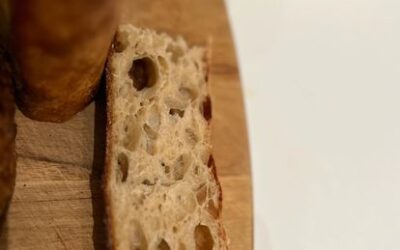While anxious to bake whenever humanly possible, it’s not always easy to schedule around my wife badgering me about flour here and there or with my work taking over my life. I try now to be frugal making smaller loaves and one at a time, in light of the current world picture and economics. My wonderful sister sent me a package of Bise flour, or high extraction flour, in two flavors no less, wheat and spelt. So I went for making some Miche, and thought to make Susans version handsome looking specimens . First thing I did was use some rye, perhaps why this sickly and over proofed loaf went awry? I followed Susans instruction to the final letter, but somehow even with a cold fridge this loaf was exploding and seemed really active, perhaps the flour had some kick, it was from Demeter. There has been some differing opinions on retarding bread on forums of late, and I for one have always let my dough sit a bit and warm up so it won’t be shocked into baking with bursts and a pale horse look! This Miche on the other hand was a rapid riser, and seemed somewhat overproofed even with the 12 hours retarded, came out deflated and flat with the pallid look I hate especially with Susans sexy looking version she displayed! Dan Lepard has a competition on The Guardian asking for some baking tips, maybe someone could help me here or am I retarded?
Sourdough Croissants
I love croissants. I love everything about them. Their layers of texture, from their crispy outside to their buttery...







That looks light a pretty good miche to me! (I’d eat it!)
However if you’re worried about colour – a pale look is usually indicative of the fermentation having run for too long – depleting the sugars released through amylase.
With regards to the ‘deflated’/’flat’ look, this may have come from protease running for too long during the retardation period – which weakens the gluten. Perhaps lower the temperature in the refrigerator? How much rye were you using?
Personally, with high extraction breads I rarely use retardation.
Perhaps you could explain why you retarded the dough?
(oops I seem to be asking more questions than offering answers!)
For comparison’s sake, it is my understanding that the classic poilane miche take about 4 hours, start to finish (not including the ferment time for the ‘old dough’) – no refrigeration required.
My ‘tips’ (if you can call them that) is for a more open crumb, consider soaking a portion of the flour for the final dough, prior to adding the remaining flour and levain. Use a series of folds in the bulk ferment rather than intensive mixing. Also you could try baking under a cloche or inverted bowl for the first 15 minutes (spray the miche with water before placing in the oven).
Hope that helps
–FP
Thanks FP, the taste is actually good, I should of left the dough to retard in bulk then bring it up to temperature and finish the final shape and proof, the rye was minimal in the first build of the leaven. All in all it tastes good, looks ugly,a compromise?!
Hmm, definitely sounds like it was overproofed. What was the dough temp? Or maybe underbaked? Even so, I’d rather have a tasty but ugly loaf than the other way around (I’m not saying yours looks ugly, though).
Susan,
Definitely was a case of overproofing, in my own humble opinion, next time I think I will just bake it rather than give it that long hibernation in the fridge!!! It’s an ugly duckling but tastes good;)